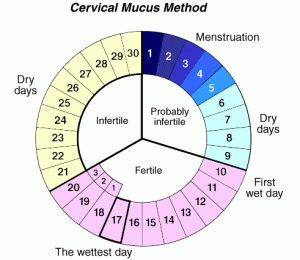Fertility Awareness
Fertility Awareness Method (FAM) is a collection of practices that help a woman know which part of the month she is most likely to get pregnant. Fertility Awareness is 76% effective at preventing pregnancy if practiced correctly. A woman can learn when ovulation (ovary releasing an egg) is coming by observing her own body and and charting physical changes. She can then use this information to avoid or encourage pregnancy. Fertilization occurs if egg and sperm meet during the next few hours and days right after ovulation. The most effective way to discover YOUR fertile time is to practice all of the techniques described here.
Fertility Awareness increases a woman’s understanding of her body and her menstrual cycle. To be effective as birth control, it requires her to abstain from intercourse or use a barrier method or withdrawal for birth control during her fertile time, approximately one-third of the month.
If you are want to use Fertility Awareness, please seek additional information from the resources listed at the end.
Fertility Awareness is a form of Natural Family Planning. However, the term ‘Natural Family Planning’ does not always mean the comprehensive valid approach known as Fertility Awareness Method.
Fertility Awareness Method relies upon the following assumptions:
- An egg (ovum) can live inside a woman’s body for 12-24 hours. However, in calculating the fertile time we use 48 hours in case more than one egg is released.
- Sperm can live in a woman’s body up to 5 days after intercourse, though more often 2 days. Pregnancy is most likely if intercourse occurs anywhere from 3 days before ovulation until 2-3 days after ovulation.
- Since the exact time of ovulation cannot be predicted, we add 2 to 3 days to the beginning and end.
- Day 1 in the Menstrual Cycle is the first day of bleeding.
A woman’s fertile time (“unsafe days” if she wants to prevent pregnancy) is thus about one-third of her cycle.
How Fertility Awareness Works
Pregnancy is prevented by not having sexual intercourse during the unsafe fertile time, or by using a barrier method such as male or female condom, cervical cap, diaphragm or withdrawal during the fertile time. Alternatively, if a woman wants to get pregnant, she can know when is the best time to have intercourse that is most likely to result in a pregnancy.
The more regular a woman’s cycle is, the more reliable Fertility Awareness is. As a woman becomes more familiar with the signs of ovulation and the pattern of her menstrual cycle, Fertility Awareness Method becomes more effective for her.
Below we describe the ‘practices’ that help a woman determine when her fertile phase or fertile time is.
Monitor Cervical Mucus
To chart your cervical mucus, observe and record your cervical secretions every day on a calendar or chart. Day 1 is the first day of your menstrual period.
Using a plastic speculum for vaginal and cervical self examination, a woman can learn to see the changes in the os (opening to the cervix) and watch it open as ovulation approaches. Within the os, fertile cervical mucus appears clear and shiny. You may touch and feel this mucus from the speculum after you take it out.
Alternatively, to collect the mucus, wipe yourself front to back with your fingers collecting the secretions from your vaginal opening. Look for a sensation of wetness. Note the color (yellow, white, clear or cloudy) and consistency (thick, sticky, stretchy) as well as how it feels (dry, wet, sticky, slippery, stretchy).
When monitoring your mucus, do not douche as it washes away the secretions. Do not use spermicidal gel, foam, cream or suppositories as they can mask or affect your mucus, making it difficult to identify the changes. Some practitioners warn that during menstruation and the first dry days after menstruation, you should only have intercourse every other day to ensure you do not miss the first signs of increased secretions. You can use male or female condoms to keep semen out of the vagina and to protect yourself from sexually transmitted infections and HIV.
To chart your cervical mucus, observe and record your cervical secretions every day on a calendar or chart. Day 1 is the first day of your menstrual period.
Using a plastic speculum for vaginal and cervical self examination, a woman can learn to see the changes in the os (opening to the cervix) and watch it open as ovulation approaches. Within the os, fertile cervical mucus appears clear and shiny. You may touch and feel this mucus from the speculum after you take it out.
Alternatively, to collect the mucus, wipe yourself front to back with your fingers collecting the secretions from your vaginal opening. Look for a sensation of wetness. Note the color (yellow, white, clear or cloudy) and consistency (thick, sticky, stretchy) as well as how it feels (dry, wet, sticky, slippery, stretchy).
When monitoring your mucus, do not douche as it washes away the secretions. Do not use spermicidal gel, foam, cream or suppositories as they can mask or affect your mucus, making it difficult to identify the changes. Some practitioners warn that during menstruation and the first dry days after menstruation, you should only have intercourse every other day to ensure you do not miss the first signs of increased secretions. You can use male or female condoms to keep semen out of the vagina and to protect yourself from sexually transmitted infections and HIV.
Calendar Method
In Calendar Charting a woman charts her menstrual periods and uses the length of her past menstrual cycles to estimate the fertile time. When she knows the shortest and longest cycles over several months, she can use a formula to estimate the fertile time.
Start by keeping a written record of your menstrual cycle for 8-12 consecutive months. Make a chart showing each month and how many days from one menstrual cycle to the next. Count the first day of menstruation (the first of bleeding) as “Day 1” of your cycle.
Example: Count the number of days between Day 1 of one period and Day 1 of the next period.
|
March
|
29 days
|
|
|
April
|
26 days
|
(shortest cycle)
|
|
May
|
30 days
|
|
| June | 31 days | (longest cycle) |
| July | 30 days |
Now, pick your longest and shortest cycles. Subtract 18 from the length of your shortest cycle and note this as the first fertile day. Subtract 11 from the length of your longest cycle and this is the last fertile day.
In this example, the shortest cycle is 26 days and the longest is 31 days. Subtract 18 from 26 to get the first unsafe day, that is Day 8. Subtract 11 from 31 to get Day 20 as the last unsafe day. Therefore, Days 8-20 are the fertile time.
Once you have a record of your cycles, the following table will help you determine your fertile unsafe days.
| Shortest Period | First Unsafe Day | Longest Period | Last Unsafe Day | |
|---|---|---|---|---|
| 21 days | 3rd day | 21 days | 10th day | |
| 22 days | 4th day | 22 days | 11th day | |
| 23 days | 5th day | 23 days | 12th day | |
| 24 days | 6th day | 24 days | 13th day | |
| 25 days | 7th day | 25 days | 14th day | |
| 26 days | 8th day | 26 days | 15th day | |
| 27 days | 9th day | 27 days | 16th day | |
| 28 days | 10th day | 28 days | 17th day | |
| 29 days | 11th day | 29 days | 18th day | |
| 30 days | 12th day | 30 days | 19th day | |
| 31 days | 13th day | 31 days | 20th day | |
| 32 days | 15th day | 32 days | 21st day | |
| 33 days | 15th day | 33 days | 22nd day | |
| 34 days | 16th day | 34 days | 23rd day | |
| 35 days | 17th day | 35 days | 24th day | |
| 36 days | 18th day | 36 days | 25th day |
Here’s another example: if a woman’s menstrual record shows her shortest cycle was 25 days and her longest was 30 days, her unsafe fertile days are Day 7 up to and including Day 19, counting from Day 1 as the first day of her period.
Keeping Your Chart Up to Date: Each month add the number of days between periods to the chart and re-calculate your predictions of fertile times. As your chart grows, cross off the oldest cycles and only consider the past 12 months.
|
|
|
|
|
|
|
|
|
May
|
30 days
|
|
| June | 31 days | (longest cycle) |
| July | 30 days | |
| August | 27 days | |
| September | 28 days | |
| October | 29 days | |
| November | 27 days | |
| December | 30 days | |
| January | 29 days | |
| February | 28 days | |
| March | 27 days | (shortest cycle) |
| April | 30 days |
Basal Body Temperature (BBT)
When a woman monitors her Basal Body Temperature (BBT) she can see when ovulation happened after it has occurred. BBT helps identify post-ovulatory infertile (safe) days.
Using an easy-to-read thermometer, take your temperature every morning immediately upon waking and before any activity. Use graph paper so you can see the rise and fall of temperature (see below).
Immediately before ovulation, the temperature drops briefly. Within 12 hours of ovulation the BBT rises several tenths of a degree and remains up until the next menstrual period. When your temperature stays high for 3 days in a row, the fertile period is over and the safe infertile time begins.
The main drawback of using the BBT method by itself, is that several factors can influence your BBT, including illness, lack of sleep, alcohol or drug use.

Record your temperatures on a chart similar to the one above, along with your cervical fluid and the next technique, cervical observation. Keep a chart of your BBT over a period of 8-12 consecutive months to learn the approximate time in your cycle when you usually ovulate.
Cervical Observation
The position of a woman’s cervix changes over the course of her menstrual cycle. Typically, during and in the first few days after menstruation, the cervix is fairly low and firm like the tip of your nose. When the wet cervical fluid begins to show, the cervix begins to move up, become more soft, wet, and open. During ovulation, the cervix is at its highest and most open. After ovulation, the cervix returns to the firm, low, and closed position.
To observe the changes in cervical position, wash your hands, insert your middle finger, and feel your cervix for softness, height, opening, and wetness. A plastic speculum can be helpful in the beginning while you are getting used to finding and feeling your cervix. Check your cervix about the same time of day and in the same position (squatting, sitting on the toilet, or with one leg raised).
Add to your chart a record of the appearance, softness/firmness, and wetness of the cervix.
More Signs
In addition to the changes described above, other physical changes may occur mid-cycle, around the time of ovulation (lasting only a day or less), including:
- Slight one-sided pain or cramp in the area of an ovary in the lower abdomen
- Spotting
- Breast tenderness
Effectiveness
To prevent pregnancy, a woman should abstain from intercourse, or use a barrier method of birth control during her fertile days: 5 days before ovulation through 3 days after ovulation, about one-third of her cycle.
The effectiveness of FAM for birth control varies, depending on the dedication and motivation of the woman and her partner, the length of time she has been using it and the regularity of her menstrual cycle. Combining multiple techniques, as discussed here, increase the effectiveness. Of 100 women who have no vaginal intercourse during their fertile time, between 2 to 20 will become pregnant during the first year. By comparison 60 to 80 women out of 100 who use no birth control will become pregnant.
It is helpful to learn these techniques directly from a qualified instructor if you can find one. Books and websites also have good information.
New technologies such as calculators, computer programs, saliva tests and urine tests can also help determine fertile time. These high tech methods may be especially valuable to women who have had trouble getting pregnant.
Advantages
- No health risks or side effects to the woman.
- Can be used to plan or prevent pregnancy.
- Effective if used correctly and consistently, especially for women who have regular menstrual periods.
- Acceptable for couples with religious concerns about contraception.
- Can increase a woman’s awareness and understanding of her body.
- Couples may develop greater communication, cooperation and responsibility.
- For couples who choose not to abstain during the fertile time, barrier methods at that time offer considerable protection against pregnancy.
Disadvantages
- Learning to use the method takes time and effort.
- Requires considerable commitment, calculation and self-control, both by the woman and her partner.
Learn More
- Toni WeschlerMPH, the Seattle woman who teaches Fertility Awareness, says “it should be seen as a fundamental life skill that all women should learn, just as they are now taught basic feminine hygiene.” Read her book Cycle Savvy – the smart teens guide to the mysteries of her body – everything you want to know about your monthly cycle (includes downloadable charts for you to use).
- GardenofFertility.com posts several articles about Fertility Awareness and photos showing the changes the cervix goes through during a natural menstrual cycle. It offers fertility charts that can be downloaded at no charge. Find in-depth info in the book published in 2004 entitled The Garden of Fertility: A Guide to Charting your Fertility Signals to Prevent or Achieve Pregnancy — Naturally — and to Gauge your Reproductive Health by Katie Singer. The book describes the changes a woman experiences throughout the menstrual cycle; how to chart your fertility signals (the waking temperature and cervical fluid); how to determine, by fertility charts, when you are fertile and not fertile; how to practice natural birth control that is virtually as effective as the Pill; and when to time intercourse if you want to conceive. It explains how to identify, by your fertility charts, whether you’re ovulating, indicating a propensity for thyroid problems, poly-cystic ovarian syndrome, or miscarriage. It tells how to establish and identify unambiguous infertility while breastfeeding, and how to identify when ovulatory cycles are resuming.
- Color-coded Cycle Beads can be a fun way to keep track of where you are in your own cycle. Cycle Beads website has further information on fertility awareness. Includes online and smartphone apps.
- Period tracker is another online and Smartphone application.
- Fertility Awareness Center
- Society for Menstrual Cycle Research – a nonprofit organization and multidisciplinary group of women pioneers in understanding the centrality of menstrual cycle research to women’s health.
- Menstrual Calendar – charting and saving your monthly cycle on your computer.





